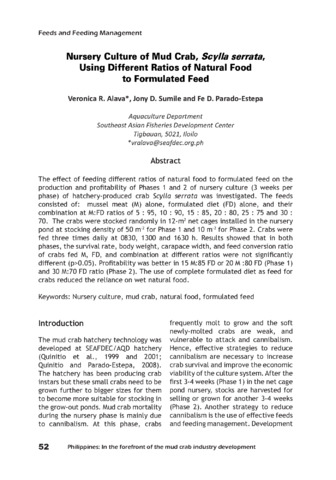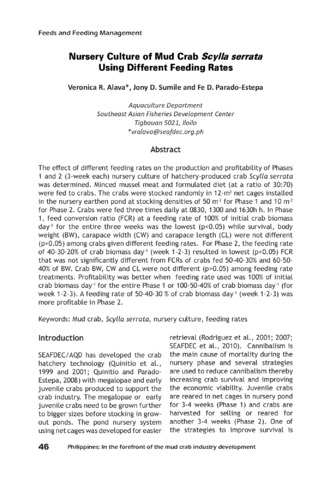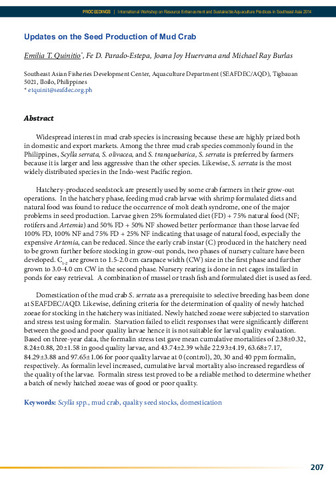Development of hatchery techniques for the mud crab Scylla serrata (Forskål): Comparison of feeding schemes
Share
Abstract
Scylla serrata larvae were reared in 3 L plastic containers and fed various amounts of artificial diets (AD) with or without natural food (NF: Brachionus rotundiformis and newly-hatched Artemia). The amounts of AD fed alone to zoea in treatments (T) 1 to 4 were as follows: 1) 2.0 mg/L/day + 0.25 mg/L/day increment/substage; 2) 2.0 mg/L/day + 0.5 mg/L/day increment/ substage; 3) 4.0 mg/L/day + 0.5 mg/L/day increment/substage; 4) 4.0 mg/L/day + 1.0 mg/L/day increment/ substage. NF were given in addition to the respective amounts of artificial diet in T5, T6, T7 and T8. T9 served as the control (NF only). Based on three experimental runs, only larvae in T5, T6, and T9 survived until the megalopa stage. Thus, only these three treatments were compared in succeeding experiments using a commercial shrimp diet in 250 L fibreglass tanks. Of the three runs conducted using a commercial diet, two runs showed significant differences (P<0.05) in survival. T5 gave higher survival (3.71% and 1.33%) than T9 (1.84% and 0.45%) and T6 (1.37% and 0.45%). Population development index did not differ among treatments in three runs.
Suggested Citation
Quinitio, E. T., Parado-Estepa, F., & Alava, V. (1999). Development of hatchery techniques for the mud crab Scylla serrata (Forskål): Comparison of feeding schemes. In C. P. Keenan & A. Blackshaw (Eds.), Mud Crab Aquaculture and Biology. Proceedings of an international scientific forum held in Darwin, Australia, 21–24 April 1997 (pp. 125-130). Canberra: Australian Centre for International Agricultural Research.
Subject
Collections
Related items
Showing items related by title, author, creator and subject.
-
Nursery culture of mud crab, Scylla serrata, using different ratios of natural food to formulated feed
Alava, Veronica R.; Sumile, Jony D.; Parado-Estepa, Fe D. (Aquaculture Department, Southeast Asian Fisheries Development Center, 2017)The effect of feeding different ratios of natural food to formulated feed on the production and profitability of Phases 1 and 2 of nursery culture (3 weeks per phase) of hatchery-produced crab Scylla serrata was investigated. ... -
Nursery culture of mud crab Scylla serrata using different feeding rates
Alava, Veronica R.; Sumile, Jony D.; Parado-Estepa, Fe D. (Aquaculture Department, Southeast Asian Fisheries Development Center, 2017)The effect of different feeding rates on the production and profitability of Phases 1 and 2 (3-week each) nursery culture of hatchery-produced crab Scylla serrata was determined. Minced mussel meat and formulated diet (at ... -
Updates on the seed production of mud crab
Quinitio, Emilia T.; Parado-Estepa, Fe D.; Huervana, Joana Joy; Burlas, Michael Ray (Aquaculture Department, Southeast Asian Fisheries Development Center, 2015)Widespread interest in mud crab species is increasing because these are highly prized both in domestic and export markets. Among the three mud crab species commonly found in the Philippines, Scylla serrata, S. olivacea, ...




